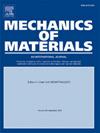基于应力不变式的屈服函数及其扩展:建模与验证
IF 3.4
3区 材料科学
Q2 MATERIALS SCIENCE, MULTIDISCIPLINARY
引用次数: 0
摘要
在塑性变形过程中,材料的力学响应往往受到应力状态和各向异性效应的影响,现有的许多屈服函数难以准确表征这一现象。本文提出了一种基于应力不变量的屈服函数,它可以涵盖现有的各种相关模型并对其进行进一步扩展,进行了参数敏感性分析和凹凸分析,并分析计算了四种基本应力状态下的函数参数。使用该函数描述了 AA7075-T6、QP1180、AA5754-O 和 DP980 四种金属的应变硬化行为。分析了参数分析计算和拟合计算方法的优缺点。在此基础上,扩展了该函数的静水压力非线性依赖性,并用于描述低密度、高密度和 Duocel 三种金属泡沫的屈服行为以及岩石材料的破坏行为。利用 Balat'91 线性变换张量将函数扩展到各向异性,描述了 AA2008-T4 的各向异性屈服行为,利用插值法描述了锆板的各向异性硬化行为。结果表明,本文提出的屈服函数可以准确预测金属材料的各向异性屈服和硬化行为、泡沫金属的屈服行为以及岩土材料的断裂特性。本文章由计算机程序翻译,如有差异,请以英文原文为准。

A yield function based on stress invariants and its extensions: Modeling and validation
During the process of plastic deformation, the mechanical response of materials is often influenced by stress states and anisotropic effects, and many existing yield functions are difficult to characterize this phenomenon accurately. This article proposes a yield function based on stress invariants that can encompass a variety of existing relevant models and further expand upon them, conducts parameter sensitivity analysis and concavity convex analysis, and analytically calculates the function parameters under four fundamental stress states. The strain-hardening behavior of four metals, AA7075-T6, QP1180, AA5754-O, and DP980, was described using this function. The advantages and disadvantages of parameter analysis calculation and fitting calculation methods were analyzed. On this basis, the nonlinear dependence of the hydrostatic pressure of the function is expanded and used to describe the yield behavior of three metal foams, namely low-density, high-density, and Duocel, and the failure behavior of rock materials. Extend the function to anisotropy using the Balat'91 linear transformation tensor to describe the anisotropic yield behavior of AA2008-T4, using the interpolation method to describe the anisotropic hardening behavior of zirconium plates. The results show that the yield function proposed in this paper can accurately predict the anisotropic yield and hardening behavior of metal materials, foam metal yield behavior, and geotechnical materials' fracture characteristics.
求助全文
通过发布文献求助,成功后即可免费获取论文全文。
去求助
来源期刊

Mechanics of Materials
工程技术-材料科学:综合
CiteScore
7.60
自引率
5.10%
发文量
243
审稿时长
46 days
期刊介绍:
Mechanics of Materials is a forum for original scientific research on the flow, fracture, and general constitutive behavior of geophysical, geotechnical and technological materials, with balanced coverage of advanced technological and natural materials, with balanced coverage of theoretical, experimental, and field investigations. Of special concern are macroscopic predictions based on microscopic models, identification of microscopic structures from limited overall macroscopic data, experimental and field results that lead to fundamental understanding of the behavior of materials, and coordinated experimental and analytical investigations that culminate in theories with predictive quality.
 求助内容:
求助内容: 应助结果提醒方式:
应助结果提醒方式:


